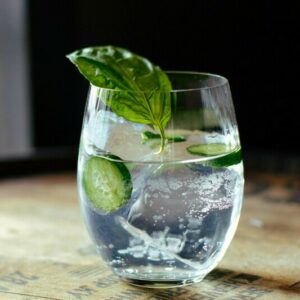How To Make A Gin and Tonic Cocktail: The Ultimate Guide
I’m your host, KAD, and I’ve been slinging drinks and navigating the world of hospitality for over two decades. The past 15 years, I’ve perfected my bartending skills, experimented with countless flavor combinations, and learning a thing or two about how to keep the party going behind the bar.
Whether you’re a seasoned bartender like me just looking for some fresh inspiration or a complete beginner who is eager to whip up impressive cocktails at home, Shake, Sip, Serve is here to be your guide.
In the below blog, I’ll be sharing my knowledge and experience on everything from classic cocktails and innovative new creations to essential bartending techniques and industry secrets. I’ll also be offering tips on stocking your home bar, mastering the art of presentation, and creating a memorable experience for your guests.
So, grab your shaker, dust off your favorite glassware, and get ready to embark on a delicious journey into the world of bartending!
Let’s Shake, Sip, and Serve up something amazing together.
Disclaimer: This post contains affiliate links. If you purchase through these links, I may earn a small commission at no additional cost to you.
Why the Gin and Tonic Endures
Few cocktails deliver so much with so little. A great G&T is crisp, aromatic, and effortlessly refreshing. Juniper-led botanicals from the gin meet quinine’s gentle bitterness from tonic water, while citrus oils lift the whole experience. With only a handful of components, technique and ingredient quality matter—when you get them right, the drink sings.

A Short History of the G&T
The Gin and Tonic traces back to the 19th century when quinine (from cinchona bark) was used to help manage malaria in tropical regions. Quinine on its own is intensely bitter; mixed with sugar, water, lime, and gin, it became not only palatable but enjoyable. Its medicinal origins faded; the balanced, bubbly highball remained and evolved into the modern classic we love today.
The Three Pillars: Gin, Tonic, Citrus
1) Gin
Choose a style that suits your palate and the tonic you plan to use.
-
London Dry (classic, juniper-forward): Tanqueray, Beefeater.
-
Citrus-forward modern dry: Bombay Sapphire, Tanqueray No. Ten.
-
Floral/culinary: Hendrick’s (cucumber, rose).
-
Australian craft: Four Pillars Rare Dry, Never Never Triple Juniper—excellent options for a local twist.
2) Tonic Water
Tonic is half the drink—don’t compromise. Seek balanced bitterness, fine bubbles, and restrained sweetness.
-
Premium picks in AU: Fever-Tree, CAPI, StrangeLove.
-
Flavoured tonics: Mediterranean, light/low sugar, elderflower—great for pairing with specific gin styles.
3) Citrus & Garnish
Citrus brightens aromatics and frames bitterness. Lime is classic; lemon is softer; grapefruit is vivid; blood orange adds a bittersweet edge. Beyond citrus, consider cucumber, rosemary, thyme, pink peppercorns, or finger lime pearls for an Australian accent.
The Perfect Gin and Tonic (AU Measurements)
Ingredients (Serves 1):
-
60 ml gin (your choice of style)
-
120–150 ml chilled premium tonic water (adjust to taste)
-
1 fresh lime wedge (or lemon/grapefruit, to taste)
-
Plenty of quality ice (large, clear cubes preferred)
Glassware: Highball (classic) or a balloon “copa” glass to amplify aroma.
Method:
-
Chill the glass. Either refrigerate or fill with ice while you set up.
-
Measure the gin. Add 60 ml to the chilled glass.
-
Add ice—lots of it. Fill the glass to the brim with large cubes. More ice = colder drink, less dilution.
-
Add tonic gently. Pour 120–150 ml down the inside of the glass or over the back of a spoon to protect carbonation.
-
Stir briefly. One or two gentle turns to integrate without knocking out bubbles.
-
Citrus last. Express a lime wedge over the top to release oils, then drop it in (or skip the drop-in if you prefer a cleaner, drier finish).
-
Taste and adjust. Add a touch more tonic if you want a lighter, spritzier profile.
Pro ratio: Start at 1:2 (gin:tonic). For stronger botanicals or a slower session, drift toward 1:2.5–1:3.
Technique Tips from Behind the Bar
-
Cold is king. Keep your tonic refrigerated; warm tonic kills fizz.
-
Mind the pour. A hard glug will blow off bubbles; a gentle slide preserves them.
-
Ice quality matters. Clear, dense cubes melt slower and keep flavours focused.
-
Garnish with intention. Match garnish to gin: cucumber/rose for floral gins; grapefruit peel for citrus-led; rosemary for herbaceous profiles.
-
Don’t over-lime. Too much citrus can flatten quinine’s pleasant bite.
Garnish & Pairing Guide
-
Classic: Lime wedge or wheel.
-
Citrus lift: Grapefruit peel and a tiny pinch of sea salt.
-
Garden fresh: Cucumber ribbon and dill with floral gins.
-
Mediterranean: Lemon wheel and thyme with Mediterranean tonic.
-
Australian native twist: Finger lime pearls or lemon myrtle leaf (lightly bruised).
Food pairings: Fresh oysters, prawn cocktails, grilled fish with lemon, soft goat’s cheese, herb-forward salads.
Five G&T Variations to Try
-
Elderflower G&T
-
60 ml dry gin, 150 ml elderflower tonic, cucumber ribbon, mint. Bright, floral, summer-ready.
-
-
Citrus Trio G&T
-
60 ml citrus-forward gin, 120 ml classic tonic, wheels of lemon, lime, grapefruit. Zesty and aromatic.
-
-
Rosemary & Pink Peppercorn G&T
-
60 ml London Dry, 120–150 ml tonic, rosemary sprig, a few pink peppercorns. Savoury with subtle spice.
-
-
Cucumber & Basil G&T
-
60 ml floral gin, 150 ml tonic, cucumber ribbon, basil leaf. Cooling, herbal, perfect for heat.
-
-
Native Aussie G&T
-
60 ml Australian gin, 120–150 ml tonic, finger lime pearls, lemon myrtle. Local botanicals up front.
-
Troubleshooting Common G&T Mistakes
-
It tastes flat: Tonic wasn’t cold enough or was poured too aggressively; use fresh, sealed bottles.
-
It’s watery: Not enough ice or too much stirring; pack the glass with large cubes.
-
It’s too sweet: Switch to a drier tonic or lengthen with soda (30–50 ml) while keeping aromatics intact.
-
Gin is lost: Reduce tonic to 120 ml, or choose a more assertive gin.
FAQs
What’s the best glass for a G&T?
Highball for a clean, tall serve; balloon/copa for amplified aroma and more room for ice and garnish.
Do I need premium gin to make a great G&T?
You need a gin you enjoy neat—clean, balanced, and not harsh. Premium helps, but smart pairing with the right tonic matters more.
Can I batch G&Ts?
Pre-chill gin and glassware. Pour to order; add tonic per serve to keep carbonation lively.
How many standard drinks is a G&T?
Roughly 1.6–1.8 Australian standard drinks with 60 ml of 40% ABV gin and 0% ABV tonic. Always check your gin’s ABV.
RSA: Enjoy Responsibly
Serve thoughtfully and pace your drinks. Offer lighter ratios and alcohol-free options (swap gin for a quality distilled non-alcoholic spirit, top with tonic, garnish as usual). Provide water on the table, and plan safe transport. For detailed guidance, see Liquor & Gaming NSW: https://www.liquorandgaming.nsw.gov.au/
Closing Statement
The bartending community is a vibrant and supportive one, and I’m excited to build that community here on Shake, Sip, Serve.
I’d love to hear your thoughts, questions, and experiences in the comments below.
What are you shaking up these days?
What topics would you like to see covered in future posts?
Let’s connect and continue the conversation!
Liquor & Gaming NSW: This website provides information on liquor licensing, responsible service of alcohol (RSA) training, and regulations for serving alcohol in NSW. It’s essential for anyone working in the hospitality industry in NSW. You can find it here: https://www.liquorandgaming.nsw.gov.au/
Read More:
Bloody Vampire
Witch’s Brew
Black Magic Margarita
The Zombie
Dracula’s Kiss
Pumpkin Spice White Russian
The Black Widow
Ghostly Gin & Tonic
Jack-O-Lantern Punch
Candy Corn Martini
